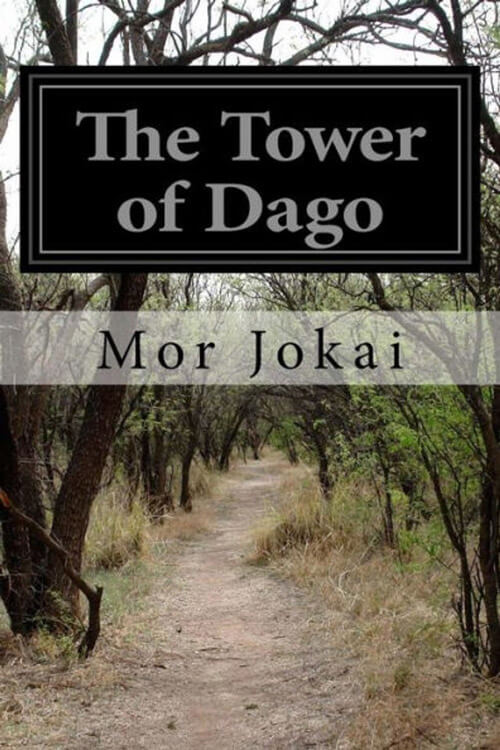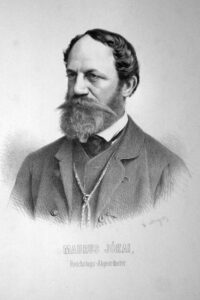
The Tower of Dago
As the steamer from Stralsund approaches the Gulf of Finland, the passenger’s attention is attracted by an object that is projected high out of the sea. He will hear the seamen call it the Tower of Dago. An old and wealthy Englishman, he may be told, on one occasion felt impelled by curiosity to ask the captain what it would cost him to examine the ruin close at hand. The answer was clothed in language less polite than forcible: “Merely the shriveled skin and dried-up bones you carry about with you, sir!”
For hitherto the Tower of Dago has been spared an appearance in our art galleries only by the circumstance that it cannot well be got before the painter’s easel. It is built upon the outermost point of a rocky promontory of the great island of Dago. The projecting headland lies obliquely across the northern current, and the sea makes a ceaseless seething whirlpool around the obstruction. The sea bottom all around is strewn with the most perilous reefs. Among their intricate labyrinths, even the skiffs of the most adroit boatmen are in danger of being dashed in pieces.
And yet, for a sight of the Tower of Dago one might well risk one’s life, especially at a time when the raging storm is clothing it with all its picturesque grandeur.
The extreme ledge of the promontory is a great block of reddish-brown rock. It rises precipitously out of the dark green waves, which incessantly storm it with their foam-crested dragon-heads. Some spring-tide monsters will often lash themselves aloft to the very summit, frightening the seagulls and eagles that love to range themselves along the verge of the rock.
From this ledge rises a six-sided tower some hundred and fifty feet high. The lower part is built in Cyclopean fashion, of massive uncut blocks of rock. The upper portion is of red stones. These reach the very summit of the tower, the battlements of which are today surmounted by the luxuriant green of juniper shrubs. And when the setting sun, bursting through a cloud, casts his rays upon the dead giant rising there in his solitude, while round about the low ashen clouds seem almost to touch his head; when the sea roars beneath and breaks in foam against his feet; when the reflected sunlight streams, like the rays of a lighthouse, from some window the panes of which are haply still unshattered—then the glowing colossus seems a very Polyphemus, who with his one eye dares to defy the gods and wage eternal feud with men. That is the Tower of Dago.
Read or download Book
Mór Jókai
Móricz Jókay of Ásva (18 February 1825 – 5 May 1904), known as Mór Jókai, was a Hungarian novelist, dramatist and revolutionary. Outside of Hungary, he was also known as Maurice Jókai Maurus Jokai or Mauritius Jókai. He was a leader of the outbreak of the Hungarian Revolution of 1848 in Pest. His romantic novels became widely popular among the elite of Victorian England, where he was often compared to Charles Dickens by the press. One of his most famous admirers was Queen Victoria herself.
Early life
He was born in Komárom in the Kingdom of Hungary to József Jókai of Ásva (1781–1837), a member of the Ásva branch of the ancient Jókay noble family; his mother was noblewoman Mária Pulay (1790–1856). As a boy, he was timid and his health delicate, so he was educated at home until the age of ten when he was sent to Pozsony (today Bratislava, Slovakia). He then attended the Calvinist college of Pápa (Pápai Református Kollégium, where he first met Sándor Petőfi and Sándor Kozma.
When Jókai was twelve, his father died. His family wanted him to become a lawyer like his father had been, and he completed his education in Kecskemét and Pest to that end. He won his first case as an independent lawyer.
Career
Jókai was bored by his work as a lawyer, and he was encouraged in his art by the praise the Hungarian Academy of Sciences gave his first play (Hungarian: Zsidó fiú, lit. ’Jewish Boy’). In 1845, he moved to Pest where Petőfi introduced him to literary circles. Within the year his first noted novel (Hungarian: Hétköznapok, lit. ’Working Days’) was published as a serial by Pesti Divatlap, followed by a hardcover edition in 1846. It was received with widespread critical acclaim. The following year, Jókai was appointed the editor of Életképek, the then-leading Hungarian literary magazine, and gathered a circle of young writers around himself.
At the outbreak of the revolution of 1848, Jókai was enthusiastic about its nationalist cause. Before the revolution, he had been a moderate liberal who opposed excesses, but the nationalist victories of April and May 1849 persuaded him to support Lajos Kossuth’s deposition of the then-reigning House of Habsburg. When the revolutionary war ended in defeat, he was present at the surrender at Világos (today Şiria, Romania) in August 1849. He intended to commit suicide to avoid imprisonment, but his wife, Róza Laborfalvi helped him escape on foot through Russian lines to Pest.
For the next fourteen years, Jókai was politically suspicious of the regime. He devoted himself to the rehabilitation of the Hungarian language, writing thirty novels and volumes of tales, essays, and literary criticism. His renowned works Erdély aranykora (‘The Golden Age of Transylvania’), its sequel Török világ Magyarországon (‘The Turks in Hungary’), Egy magyar nábob (‘A Hungarian Nabob’), its sequel Kárpáthy Zoltán, Janicsárok végnapjai (‘The Last Days of the Janissaries’), and Szomorú napok (‘Sad Days’) were written during this time.
After the re-establishment of the Hungarian constitution by the Austro-Hungarian Compromise of 1867, Jókai took an active part in politics. He was a long-time supporter of Kálmán Tisza’s administration, sitting for over twenty years in parliament and founding the government paper A Hon in 1863. In 1897, King Francis Joseph appointed him a member of the Upper House. In 1899, he caused a country-wide scandal by marrying Bella Nagy, a twenty-year-old actress.
Jókai died in Budapest on 5 May 1904. He was buried with his first wife (who had died in 1886) in the Fiume Road Graveyard.






